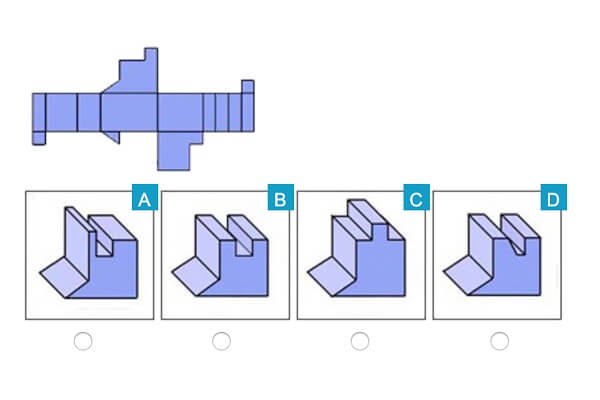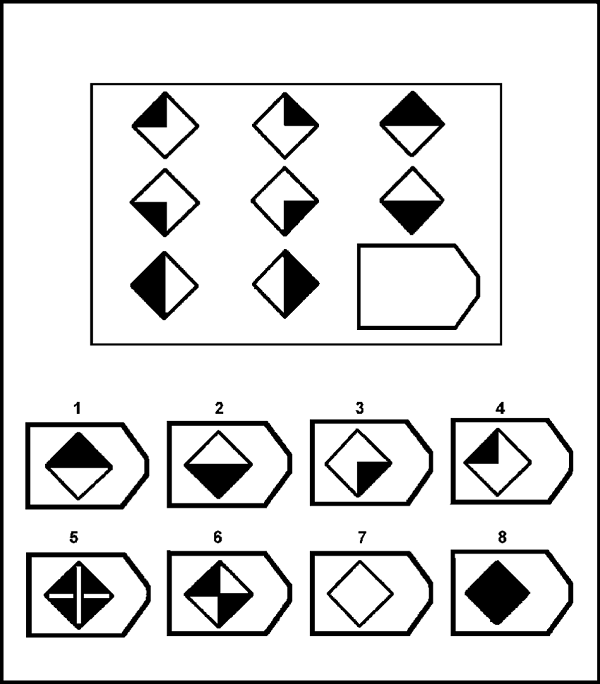Content
Spatial reasoning—sometimes referred to as spatial intelligence—is the cognitive ability to mentally manipulate, visualize, and transform objects in space. It includes understanding how items relate to one another visually and spatially, whether in two or three dimensions.
In pre-employment testing, academic settings, and psychological evaluations, a spatial reasoning test is often used to measure spatial awareness, spatial recognition, and problem-solving skills related to visual-spatial manipulation. These spatial awareness tests are particularly valuable when hiring for roles that demand technical accuracy, design thinking, or mechanical aptitude.
What Is Spatial Reasoning?
Spatial reasoning—also known as spatial intelligence—refers to the mental ability to visualize, manipulate, and interpret objects in two and three dimensions. It plays a major role in how we understand space, distance, depth, shapes, and object relationships.
In psychology and talent acquisition, spatial reasoning is one of several forms of intelligence described by Howard Gardner in his theory of multiple intelligences. Today, employers often assess spatial awareness, spatial recognition, and spatial reasoning skills during the hiring process using a structured spatial reasoning test.
Why? Because these spatial awareness tests offer a clear way to evaluate how a candidate interprets visual data, mentally rotates objects, and solves geometric or spatial problems—skills that are essential in many technical, design, and operational roles.
Candidates with strong spatial reasoning abilities typically perform well on tasks involving:
- Shape recognition and transformation
- Mental rotation of 2D and 3D objects
- Visual comparison and pattern identification
- Map reading and spatial navigation
- Diagram and plan interpretation
- Block, mirror, and reflection puzzles
In pre-employment settings, we use spatial reasoning tests as part of a broader cognitive ability assessment strategy. These tests help identify top talent by isolating one of the most job-relevant cognitive skills: spatial awareness. That’s why understanding what spatial reasoning skills are and how to assess them effectively is now a key step in many companies’ hiring processes. It’s a form of intelligence that’s often overlooked but incredibly valuable across engineering, design, architecture, logistics, and many other fields.
What is a Spatial Reasoning Test?

Think of a spatial reasoning test like a series of online puzzles that shows how well you can twist, turn, and fit shapes together in your mind. These challenges are a fun branch of cognitive ability tests—they measure how well your brain works with shapes, patterns, and logic. Instead of words or numbers, you’ll work with 2D and 3D figures—imagining how a block would look if you flipped it, or which piece completes a pattern.
You can take these tests pretty much anywhere: from your favorite chair at home, on a company laptop in the office, or even at a formal testing center. Most quizzes are multiple-choice and give you a ticking clock to keep things moving, so you’ll need to trust your gut and go with your first instinct.
As soon as you finish, the system does the heavy lifting: it scores your answers and spits out a report. Hiring teams then use those results to see who’s quickest on their mental feet and make more targeted decisions about who moves on to the next stage.
A typical spatial awareness test evaluates how candidates process and react to 2D/3D visual stimuli under timed conditions. These tests provide real-time insights into how quickly and accurately someone can handle tasks that rely on spatial recognition and mental rotation—key markers of spatial intelligence in the workplace.
Spatial Reasoning Test Examples

One of the most famous such reasoning tests is Raven’s Progressive Matrices.
Many psychologists used it to assess general intelligence in the past. Now, the RPM became one of many tests to evaluate visual-spatial intelligence rather than overall intelligence. The Raven’s Progressive Matrices is an example of a spatial intelligence test that highlights how candidates interpret abstract visual data. In hiring contexts, such tests are excellent tools for evaluating spatial recognition and abstract problem-solving skills.
In recruiting, the spatial reasoning test is just one of the many HR assessment tools experts use to ensure they hire talent and match the best candidate with the open position.
Some could argue that spatial reasoning tests resemble abstract reasoning tests, mechanical reasoning, and Matrix reasoning because they all prompt the candidate to manipulate pictograms, figures, abstract visual patterns, etc. However, the resemblance stops here.
A spatial reasoning test usually consists of a handful of instruments that evaluate a person’s ability to:
- Assemble/disassemble previously rotated object;
- Solve problems related to objects viewed from different angles;
- Manipulate surfaces/objects with different surface texture or markings;
- Work with cubes in two or three dimensions;
- Solve puzzles (shape matching ability);
- Solve problems related to maps, plans, labyrinths, etc.
When Do We Apply a Spatial Reasoning Test?
Most often than not, organizations and recruiters use spatial reasoning assessment tools to screen candidates before scheduling the first interview. You will work with some companies that want the spatial skills testing to occur before the second interview, but such cases are rare.
So why do more and more employers introduce spatial reasoning tests in the candidate screening process?
Because they save money and time as they narrow down the candidate pool to only those who show measurable skills crucial to the job tasks.
In high-volume hiring or technical screening, using a spatial awareness test can speed up decision-making while improving the quality of candidates selected for the next stage.
What is Spatial Reasoning Good For and Why Do We Test It?
Before answering why spatial reasoning is important (although we are sure you know already), we have to return to the definition. Spatial intelligence (or spatial reasoning) is the human ability to visualize, imagine, differentiate, and mentally operate with objects in two or three dimensions.
People who perform well on a spatial reasoning test tend to have strong spatial awareness, excellent problem-solving instincts, and the ability to mentally rotate or reimagine 3D visual data with ease.
Are you still asking yourself what spatial reasoning is good for in the hiring process? As recruiters, we have to consider a spatial reasoning test when we need to find certain experts for specific domains. Such tests and other complex assessment instruments (cognitive assessment tools and other skills tests) help us hire spatial thinkers who make the best matches for those positions.
In this context, the next question becomes…
Which Career Choices Make the Best Use of Spatial Reasoning Skills?

Why are spatial skills important? Let’s answer this question first and put it into a psychological and educational context.
Visual-spatial skills allow us to perceive the visual information in the environment, to represent it internally, and integrate it with past experiences, to derive meaning and understanding, and to perform manipulations and transformations on those perceptions. These skills are important in thinking abstractly, visualizing verbal information, and recognizing how details are related to big picture ideas. Weaknesses in this area can impact basic skills such as letter formation, note-taking, and simple math computation, as well as more complex skill areas such as reading comprehension, math (e.g., estimation, geometry, trigonometry, calculus), and social skills.
We understand why spatial skills are crucial for a child and a student’s development. But what about adults looking for jobs? Here is where we come in as recruiters and human resources experts.
What Jobs Use Spatial Reasoning?
In some cases, spatial reasoning skills are the bread and butter of certain jobs. Granted, we all use some of our spatial intelligence, spatial orientation, spatial awareness, etc., during the workday. However, what experts call “spatial thinkers” – the ones with great spatial ability scores – are individuals whose brain connections help them excel in certain careers. These spatial reasoning skills can also support decision-making, risk assessment, and even data interpretation, making spatial intelligence a desirable trait across many sectors. Here are some examples!
- Architecture;
- Geosciences and environmental engineering;
- IT;
- Archeology;
- Civil and industrial engineering;
- Surveying;
- Graphic design, fashion design, etc.;
- Advertising;
- Hairstyling;
- The military, police, air traffic control, or emergency services (with an emphasis on mapping, 2D plan rotations, route planning and following, etc.);
- Professional driving;
- Industrial machinery mechanics;
- Plumbing, electricity, construction services;
- Landscaping services;
- Scientific research (biochemistry, lab technology, genetics, etc.);
- Astronomy and space engineering;
- Visual arts (animation, filmmaking, directing, multimedia creation, etc.)
Whether you’re screening for engineering, design, or logistics roles, using a spatial reasoning test is one of the most objective ways to assess true spatial awareness in real-world job scenarios.
As you can see, challenging a candidate to pass a spatial reasoning test with excellence is a surefire way to hire not only the best possible engineers but also the most talented artists.
Can One Improve Their Spatial Reasoning Skills?

Spatial skills and spatial intelligence are very hot topics in education and developmental psychology today. Studies found that early signs of spatial skills in children are excellent predictors for certain career paths having everything to do with spatial reasoning.
However, as recruiters and executives, we have to know if we can train spatial reasoning and help employees reach better spatial skills. Professional HR experts do not limit their jobs to finding the right candidates for the right jobs and help employees throughout their careers to get better positions and roles.
Recent research found that young adults could improve their spatial reasoning skills with practice. In other words, companies who design employee development programs should consider the fact that spatial reasoning is trainable – especially when they hire young candidates for junior positions.
Using a spatial reasoning test to understand how the skills evolved in an individual after gaining some work experience is vital for promotion and employee benefits programs.
Bottom Line
The use of a spatial reasoning test has become increasingly important in hiring and workforce development. These assessments offer a standardized way to evaluate spatial awareness, spatial recognition, and spatial intelligence—all key competencies in technical and creative fields. Whether you’re building a product team or managing field operations, adding a spatial awareness test to your screening process can improve accuracy, reduce turnover, and help identify high-potential talent early.
But can you use a single spatial reasoning test to know that a candidate will also be a rock star in an engineering job? Of course not. For this reason, we never use a single test or battery.
Our recommendation is to mix spatial reasoning tests with numerical reasoning tests, matrix reasoning, cognitive ability assessments, structured interviews, logic ability evaluations, and other skills test to predict job performance.
Now, it is your time to speak your mind! Have you ever used a spatial reasoning test to assess candidates for technical, engineering, and other “hard science” jobs? Did you find the instruments useful? Did they prove to be valid job performance indicators? We would love to hear your thoughts on this topic!
References
Anne U. Gold, Philip M. Pendergast, Carol J. Ormand, David A. Budd, Karl J. Mueller. Improving spatial thinking skills among undergraduate geology students through short online training exercises. International Journal of Science Education, 2018; 1 DOI: 10.1080/09500693.2018.1525621.
Kastens, K.A. and T. Ishikawa (2006). Spatial Thinking in Geosciences and Cognitive Sciences, in C. Manduca and D. Mogk (Eds.), Earth & Mind: How Geoscientists Think and Learn about the Earth. Geological Society of America Special Publication 413.
Uttal, David & Meadow, Nathaniel & Tipton, Elizabeth & Hand, Linda Liu & Alden, Alison & Warren, Christopher & Newcombe, Nora. (2012). The Malleability of Spatial Skills: A Meta-Analysis of Training Studies. Psychological bulletin. 139. 10.1037/a0028446
Wai, J., Lubinski, D., & Benbow, C. P. (2009). Spatial ability for STEM domains: Aligning over 50 years of cumulative psychological knowledge solidifies its importance. Journal of Educational Psychology, 101(4), 817–835. https://doi.org/10.1037/a0016127
